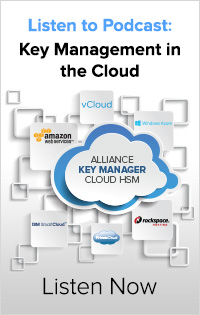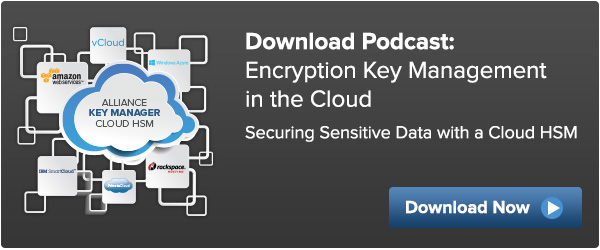What to look for in a Cloud HSM solution
With the latest advances in encryption technology, organizations are now able to protect sensitive data with encryption key management in the cloud. The lower costs for maintenance and software (on the operational side) makes the cloud an attractive place for companies to move their data centers and for technology companies to deploy their applications.
 However, these multi-tenant cloud environments provide some real challenges in terms of protecting data from exposure and meeting special requirements in terms of security. In traditional IT data center environments you would normally place a hardware security module (HSM) key management device directly into your rack. However, traditional encryption key management systems don’t function well in cloud environments, and often companies moving to the cloud don’t have a traditional IT infrastructure. This creates new issues and challenges for administrators to provide the level of security for encryption keys needed to protect data and meet compliance regulations. When considering the move of your data to the cloud, think about whether or not you will have:
However, these multi-tenant cloud environments provide some real challenges in terms of protecting data from exposure and meeting special requirements in terms of security. In traditional IT data center environments you would normally place a hardware security module (HSM) key management device directly into your rack. However, traditional encryption key management systems don’t function well in cloud environments, and often companies moving to the cloud don’t have a traditional IT infrastructure. This creates new issues and challenges for administrators to provide the level of security for encryption keys needed to protect data and meet compliance regulations. When considering the move of your data to the cloud, think about whether or not you will have:
Access:
When it comes to encryption key management, only you should have access to encryption keys that protect your data. When you consider a Cloud HSM, be sure to ask if the cloud provider will have access to the HSM and your keys. The answer may surprise you! Because the encryption keys are the “secret” that protects your sensitive information, no one else should have access to your data encryption keys or to the systems that protect those keys. This is the same rule that applies in a traditional IT infrastructure and needs to be followed when you deploy data protection in a cloud environment. Not only is it a compliance requirement to protect encryption keys, but using a secure HSM is a security best practice.
Control:
HSMs are a vital part of any data protection strategy. Encryption key managers that serve for protecting data in the cloud need to be fully under your control. To make sure that you have proper controls, your key management solution should be:
- Segmented from your cloud data
- Independent of your cloud vendor
- Able to meet the highest level of security requirements
- Designed to follow encryption key management system best practices
Mobility:
With an encryption key management and HSM solution that's protecting data in the cloud it matters where your key managers are located. If you're deploying a solution that is proprietary to your cloud vendor, your keys are locked into that cloud vendor and if you move your data, you can’t access or move your encryption keys. You also want to make sure your cloud vendor has no administrative access to that key manager. Fundamental things to think about when you deploy a key management solution:
- Are you a locked into that cloud platform?
- Do you have full and exclusive control of your keys?
Compliance regulations are very explicit about protecting sensitive data with proper encryption key management, and recommend good key management practices as a core principle. When you move to the cloud, you don’t automatically have that level of security for your data. To meet PCI-DSS requirements for protecting credit card information you should really look at the PCI-Data Security Council - Cloud Computing Guidelines as well as their guidance around virtualization since cloud environments are virtualized environments.
Excerpt from PCI-DSS Cloud Computing Guidelines - Executive Summary:
“Cloud computing is a form of distributed computing that is yet to be standardized. There are a number of factors to be considered when migrating to cloud services, and organizations need to clearly understand their needs before they can determine if and how they will be met by a particular solution or provider. As cloud computing is still an evolving technology, evaluations of risks and benefits may change as the technology becomes more established and its implications become better understood.
...
It’s important to note that all cloud services are not created equal. Clear policies and procedures should be agreed between client and cloud provider for all security requirements, and responsibilities for operation, management and reporting should be clearly defined and understood for each requirement.”
It is also important to look at the Cloud Security Alliance recommendations for cloud security - version 3. Whether you are a cloud vendor or a cloud user, the CSA provides very practical and straightforward guidance on security in the cloud environment. In order to properly secure and protect vital information, you need to understand the security posture of your cloud provider. Don't be satisfied with general statements about security, look for external audits and regular expressions of compliance reviews so you know for sure that you're truly covered. Be sure your encryption keys are in geographically dispersed data centers under an ITIL-based control environment independently validated for compliance against PCI DSS and SOC frameworks to properly manage risk.
Please download our latest Podcast “Encryption Key Management in the Cloud” which covers these topics in greater depth and also talks about how organizations deal with High Accessibility (HA) and Disaster Recovery when their HSM is in the cloud. The podcast will also cover our new Alliance Key Manager Cloud HSM solution that lets you protect data in Amazon Web Services, in Microsoft Azure, Rack-Space, or any cloud environment where you deploy data.

